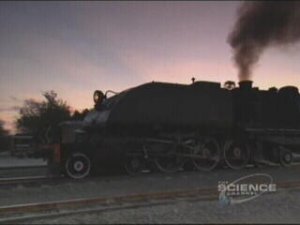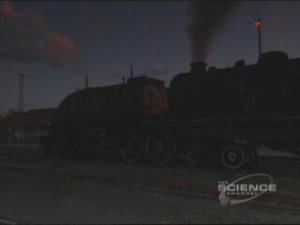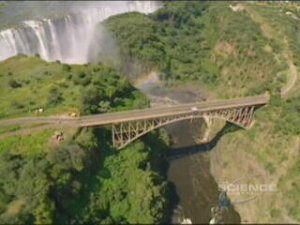I caught apart of this show featuring all sorts of trains. One that caught my eye was this train that takes turists to and across victoria falls. The track is extreamly lite weight so the loco has to have more wheels to spread out the weight. These pics were captured from the video so they are not very good.
Weird steam locomotive
- Thread starter Collyn
- Start date
You are using an out of date browser. It may not display this or other websites correctly.
You should upgrade or use an alternative browser.
You should upgrade or use an alternative browser.
N
nachoman
Garratts were quite common in many African countries and also found in Australia and even the UK. In general, it seems that railroads that emulated British practice in the steam era used Garratts when they needed articulateds, while railroads that emulated US practice used Mallets.
Actually, it was very common here in the US to spread out the weight of a locomotive to reduce the axle loadings.
Take for instance a C&O 2-6-6-6, they actually out weighed the UP 4-8-8-4s, yet had 2 fewer axles. The result was the heaviest axle loadings of any locomotive ever built...and the ultimate machine for wearing out track. (That coupled with the penalty from grossly exceeding the total weight (a danger with bridges), the Lima Locomotive Works cheated in the scale house and lied about the total weight to avoid trouble with the C&O. It was eventually discovered when the Virginian ordered their "light" alleghanies that were quoted at a higher weight the C&O alleghanies...and the ensuing settlement with the C&O caused Lima to lose money on the 2-6-6-6 design.)
An excellent example of utilizing lighter axle loadings was what occured north of the border. The Canadian National, which was similar to our Conrail, utilitzed 4-8-4s to reduce the axle loadings on it's sub-par track while the well built Canadian Pacific utilized 4-6-4s.
Btw, the Beyer-Garrat pictured would be a meter gauge locomotive. They also have berkshires & such. If I recall, part of the design was to keep some of the weight from the water on the drivers, but the downside is that if you need to start a train without much water, you have a lower factor of adhesion.
Note: a Factor of Adhesion is the ration of the weight on drivers to the tractive effort. 4.0 was considered ideal. A locomotive with a low FoA will slip alot...especially when starting a train. The N&W class A's actually had their tractive effort reduced (limited cutoff) in order to help improve their factor of adhesion. It doesn't matter how powerful a locomotive is if it slips to much to start a train.
EDIT: the well known large US steam engines...Big Boys, Challengers, Yellowstones, Alleghanies, N&W Class As, and such were NOT mallets. A mallet recycles steam while these super power locomotives generated enough steam to not need recycled steam.
Take for instance a C&O 2-6-6-6, they actually out weighed the UP 4-8-8-4s, yet had 2 fewer axles. The result was the heaviest axle loadings of any locomotive ever built...and the ultimate machine for wearing out track. (That coupled with the penalty from grossly exceeding the total weight (a danger with bridges), the Lima Locomotive Works cheated in the scale house and lied about the total weight to avoid trouble with the C&O. It was eventually discovered when the Virginian ordered their "light" alleghanies that were quoted at a higher weight the C&O alleghanies...and the ensuing settlement with the C&O caused Lima to lose money on the 2-6-6-6 design.)
An excellent example of utilizing lighter axle loadings was what occured north of the border. The Canadian National, which was similar to our Conrail, utilitzed 4-8-4s to reduce the axle loadings on it's sub-par track while the well built Canadian Pacific utilized 4-6-4s.
Btw, the Beyer-Garrat pictured would be a meter gauge locomotive. They also have berkshires & such. If I recall, part of the design was to keep some of the weight from the water on the drivers, but the downside is that if you need to start a train without much water, you have a lower factor of adhesion.
Note: a Factor of Adhesion is the ration of the weight on drivers to the tractive effort. 4.0 was considered ideal. A locomotive with a low FoA will slip alot...especially when starting a train. The N&W class A's actually had their tractive effort reduced (limited cutoff) in order to help improve their factor of adhesion. It doesn't matter how powerful a locomotive is if it slips to much to start a train.
EDIT: the well known large US steam engines...Big Boys, Challengers, Yellowstones, Alleghanies, N&W Class As, and such were NOT mallets. A mallet recycles steam while these super power locomotives generated enough steam to not need recycled steam.
<quote>the well known large US steam engines...Big Boys, Challengers, Yellowstones, Alleghanies, N&W Class As, and such were NOT mallets. A mallet recycles steam while these super power locomotives generated enough steam to not need recycled steam.</quote>
Wasn't the definition of a Mallet one that takes the exhaust steam from the high-pressure cylinders and puts it through a set of low-pressure cylinders?
No matter HOW MUCH steam these big locos generated, don't they still take the exhaust from the rear cylinders and put it through the front set?
Wasn't the definition of a Mallet one that takes the exhaust steam from the high-pressure cylinders and puts it through a set of low-pressure cylinders?
No matter HOW MUCH steam these big locos generated, don't they still take the exhaust from the rear cylinders and put it through the front set?
i thought all articulateds used the leftover steam from the rear cylinders to power the front cylinders.i have a book on it ill look it up later.
What was very common? Mallets (well, actually, most of them weren't "true" Mallets) were the preferred type of articulated in North America. There were no Garratts here.Actually, it was very common here in the US to spread out the weight of a locomotive to reduce the axle loadings.
South African railways are 3'6" gauge.Btw, the Beyer-Garrat pictured would be a meter gauge locomotive.
I was under the impression that Mallet designed the hinged locomotive and that we had both simple and compound types here in the US. The compound being the ones that reused the steam in the front drivers, hence needing larger pistons.
Garrats were extreemly popular in Africa and to some extent in Australia I believe due to the massive power they produced on relativley light axle load (remember that most of African and Australian lines are to these days 3ft 6in lines not standard gauge running modern trains at high speeds of 80kph and units developing horsepower that is similar or same to that seen on standard gauge RR's in North America.
Not all African countries use 3'6". Many use metre or standard. According to http://www.parovoz.com/spravka/gauges-en.php Australia has over 17000 km standard, 16000 km 3'6", 7000 km 5'3" and 4000 km 2'. New Zealand, whereas, is mostly if not all 3'6".
slekjr is correct in his comment about mallets, simple and compound. There is a video available about a Beyer Garrett that was bought in South Africa and returned to Great Britian for use on a tourist railroad.
Sorry  I didnt know the detailes but I did read about Garrants being the preveil type in Africa and Oceania, so I just wrote what I read
I didnt know the detailes but I did read about Garrants being the preveil type in Africa and Oceania, so I just wrote what I read  While on the topic - has anyone ever seen any model Garrats for H0 scale ?
While on the topic - has anyone ever seen any model Garrats for H0 scale ?
There is a company in Great Britian called Backwoods Minatures that either has or will have a narrow gauge Bayer Garrett available.




